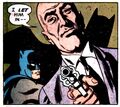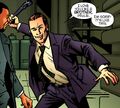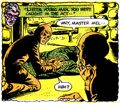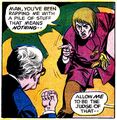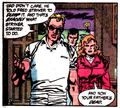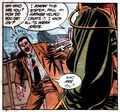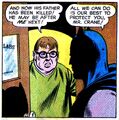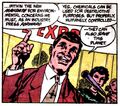The Case of the Chemical Syndicate was the first Batman story, written by Bill Finger with illustrations by Bob Kane in 1939. It was published in Detective Comics issue #27. Mike Friedrich and Bob Brown did an update for Batman's 30th anniversary in 1969, which was published in Detective Comics issue #387. Roy Thomas and Marshall Rogers retold the story in 1986, as part of Secret Origins issue #6 focusing on the Golden Age Batman. To celebrate Batman's 600th appearance in Detective Comics, two new versions of the story were printed in 1991. Marv Wolfman wrote a story with Jim Aparo illustrating, and Alan Grant wrote a story with Norm Breyfogle illustrating, both published in Detective Comics issue #627. It was updated again as part of the New 52 reboot in 2014. Brad Meltzer wrote a new version with Bryan Hitch illustrating, published in Detective Comics (Vol. 2) issue #27.[5]
Synopsis
Golden Age
Commissioner Gordon brings his young friend Bruce Wayne along while investigating the death of a chemical manufacturer named Lambert. Lambert's son is falsely accused of the murder and he implicates Lambert's partners Alfred Stryker, Paul Rogers, and Steven Crane. Steven Crane is killed by two gunmen, but a vigilante called the Bat-Man arrives in time to stop them escaping. The Bat-Man finds Paul Rogers visiting the laboratory of Alfred Stryker. Stryker's henchman Jennings locks Rogers inside a gas chamber to kill him. The Bat-Man breaks in through a skylight to rescue Rogers and punch out Jennings. It is explained that Stryker organized the murders to gain full control of their business. Stryker attacks the Bat-Man, and the Bat-Man pushes him over a railing into a tank of acid. The Bat-Man remarks that this is "a fitting end for his kind." Gordon later tells this story to Bruce Wayne, who considers it nonsense. It is revealed when he goes home that Bruce Wayne is actually the Bat-Man.[1]
Silver Age
Batman and Robin help Commissioner Gordon investigate the death of an atomic chemist named Lambert. The lead suspect is Lambert's hippy biker son Mel, who treats Batman like a fascist. Robin is outraged and wants Mel locked up, but Batman disagrees. They visit Lambert's partner Steven Crane, who tells them Lambert and Mel recently had a heated argument. Batman and Robin leave, and a gunman who looks like Mel Lambert murders Steven Crane. Paul Rogers visits Alfred Stryker, and the same gunman pistol whips him. Batman and Robin burst in to defeat Stryker and the gunman. It is revealed that Stryker hired a killer to dress like Mel Lambert and frame Mel for the murders. Stryker was attempting to eliminate his partners so he could claim their research as his own. Robin learns to be less biased, and Mel Lambert learns that sometimes the system works.[2]
Post-Crisis
This continuity has two conflicting versions of the story, both published in the same issue.
Industrialist Theodore Lambert is killed when a costumed woman covers him in highly corrosive acid. Bruce Wayne talks to Lambert's environmentalist son Ted, who is a close friend of his. Detective Hanrahan interrogates Ted, but he is not found guilty. There is a press conference held by Lambert's business partner Steven Crane. The costumed woman arrives to murder Crane and several people in the audience, calling herself Pesticyde. Batman is unable to stop her. They investigate the third partner Fred Stryker, who was crippled and disfigured in a chemical accident. It is revealed that Stryker's daughter Priscilla is Pesticyde, taking revenge on those who caused her father's accident. Pesticyde attacks the remaining partner, Paul Rogers, and reveals her identity. Batman stops her from dropping Rogers into a vat of chemicals. Pesticyde battles Batman and insists that she is not a killer, she is only seeking justice. Pesticyde tells Batman that he would do the same thing in her position. Then she accidentally destroys the catwalk she's standing on, and falls to her death in a tank of acid. Batman remarks that he would not do the same thing.[3]
Batman and Commissioner Gordon investigate the murder of chemist Professor Lambert. Their first suspect is his son Mel Lambert, who is innocent of the murder but turns out to be a cocaine smuggler. Batman investigates Lambert's partner Steven Crane, and finds him executed by two men pretending to be robbers. Batman beats the robbers and they name Paul Rogers as the man who hired them. Alfred Stryker is the real culprit, and he forces Paul Rogers to commit suicide. Rogers leaves a suicide note taking credit for the other murders, then Stryker hangs him by a noose. Batman arrives and realizes this deception, although he is too late to save Rogers. Stryker gets into a shootout with Batman and the police. Stryker tries to leap over a metal railing, and falls to his death in a tank of acid. Batman remarks that this is "a fitting end for his kind." It is explained that Stryker was responsible for handling the chemical syndicate's waste disposal. His negligence lead to the deaths of several vagrants, and he killed his partners so they wouldn't turn him in.[4]
Characters
- Alfred Stryker is originally shown as a bald fat man who plans the murders of his friends. Batman kills him by pushing him into a tank of acid.[1] In his second appearance he is slender, and Batman only has him arrested.[2] In his third appearance he is Fred Stryker, the innocent chemist at CLRS. He warns the others that their methods are unsafe. He is horribly deformed in a chemical accident and it is ambiguous whether this was incompetence or a plot by his friends to kill him. This inspires his daughter Priscilla to take revenge as Pesticyde.[3] The fourth version reverts to his original appearance. He is responsible for the chemical syndicate's waste management. When his criminal negligence kills several homeless men, he murders his partners to stop them from exposing him. Stryker tries to hop over a guard rail, but it breaks and sends him to his death in a tank of acid.[4] In The New 52 he is a slender man in a purple suit who tries to murder his business partners for trying to vote him out. He is named Alby, with no last name given. When he pulls a gun on Commissioner Gordon, Batman kicks him and he falls over a railing into a tank of acid. His hands are seen climbing out, and it is implied that he becomes the Joker.[5] The demon Barbatos once sent Batman through various hallucinations, one of them being his first case. When asking the fake Stryker (Barbatos in disguise) about his true identity, Batman is told that he already knows before "Stryker" jumps into the acid on his own, the scene changing into another illusion.[6]
- Lambert is originally given no first name. He is a slender man with a goatee, murdered with a knife.[1] In his second appearance no details are seen, but he is murdered with a fireplace poker.[2] In his third appearance he is named Theodore Lambert. He is portly with a receding hairline and runs transportation at CLRS Chemicals. Pesticyde kills him.[3] The fourth version reverts to his original appearance. He is called Professor Lambert, and murdered with a knife.[4] In The New 52 he is not seen, but described as a 67-year-old white male named Victor Lambert found dead with a knife in his chest.[5]
- Lambert, Jr. is originally seen as a dweebish young man with no first name given. He has blond hair and spectacles.[1] In his second appearance, he is an anti-establishment motorcycle-riding hippy named Mel with brown hair.[2] In his third appearance he is an idealistic friend of Bruce Wayne named Ted Lambert, Jr., with blond hair, who intends to donate his father's fortune to charity.[3] The fourth version is named Mel Lambert and similar to his first appearance, but with brown hair and no glasses. He is revealed to be a drug smuggler, despite his father's connections. When he pulls a gun on Commissioner Gordon, Batman throws cocaine in his face and punches him out.[4] In The New 52 he is not seen, and not considered a suspect, but said to have found his father murdered.[5]
- Paul Rogers is originally seen as a mustachioed man with black-and-white hair. Stryker locks him in a gas chamber, but Batman saves him.[1] In his second appearance, he has red hair and a long beard.[2] In his third appearance he has a mustache and red hair with streaks of white. He is in charge of business for CLRS Chemicals. Pesticyde ties him up over a vat of chemicals, but Batman saves his life.[3] The fourth version keeps these physical features. Alfred Stryker forces him at gunpoint to write a suicide note confessing to the other murders, then hangs him with a noose.[4] In The New 52, Paulie Rogers is a black man. Stryker locks him in a gas chamber, but Batman saves him.[5]
- Steven Crane is originally seen as a portly bald man killed in his own home.[1] In his second appearance he is also killed at home, but has glasses and a full head of hair.[2] In his third appearance he is an attractive man in charge of public relations for CLRS Chemicals. Pesticyde kills him.[3] The fourth version shows him as a fat balding man with spectacles, similar to his first appearance. Hitmen shoot him in the head and make it look like a robbery.[4] In The New 52 he is Stevie Crane, a normal-sized man with a beard who is shot in the same manner.[5]
- The original name of the chemical syndicate was the Apex Chemical Corporation.[1] There was no name given in the second version of the story.[2] In the third version it is called CLRS Chemicals after the initials of its founders.[3] The fourth version calls it G.C. Chemicals.[4] The New 52 version called it A.C.E. Chemicals which is a reference to the Joker.[5]
Issues
- Detective Comics #27
- Detective Comics #387
- Secret Origins (Volume 2) #6
- Detective Comics #627
- Detective Comics (Volume 2) #27
Recommended Reading
- Batman Recommended Reading
- Batman (Volume 1)
- Batman (Volume 2)
- Batman (Volume 3)
- Batman and Robin (Volume 1)
- Batman and Robin (Volume 2)
- Batman and Robin (Volume 3)
- Batman Confidential (Volume 1)
- Batman: Gotham Knights (Volume 1)
- Batman: Legends of the Dark Knight (Volume 1)
- Batman: Shadow of the Bat (Volume 1)
- Batman: Streets of Gotham (Volume 1)
- Batman Incorporated (Volume 1)
- Batman Incorporated (Volume 2)
- Batman/Superman (Volume 1)
- Batman/Superman (Volume 2)
- Batman/Superman: World's Finest (Volume 1)
- Batman: The Dark Knight (Volume 1)
- Batman: The Dark Knight (Volume 2)
- The Brave and the Bold (Volume 1)
- Detective Comics (Volume 1)
- Detective Comics (Volume 2)
- Superman/Batman (Volume 1)
- World's Finest (Volume 1)
Links and References
- ↑ 1.0 1.1 1.2 1.3 1.4 1.5 1.6 Detective Comics #27
- ↑ 2.0 2.1 2.2 2.3 2.4 2.5 2.6 Detective Comics #387
- ↑ 3.0 3.1 3.2 3.3 3.4 3.5 3.6 Detective Comics #627, Story 1
- ↑ 4.0 4.1 4.2 4.3 4.4 4.5 4.6 Detective Comics #627, Story 2
- ↑ 5.0 5.1 5.2 5.3 5.4 5.5 5.6 Detective Comics (Volume 2) #27
- ↑ Batman: Lost Vol 1 1
| Batman Family Storyline This event or storyline is specifically related to Batman, or to members of the Batman Family. This template will automatically categorize articles that include it into the Batman Storylines category. |


